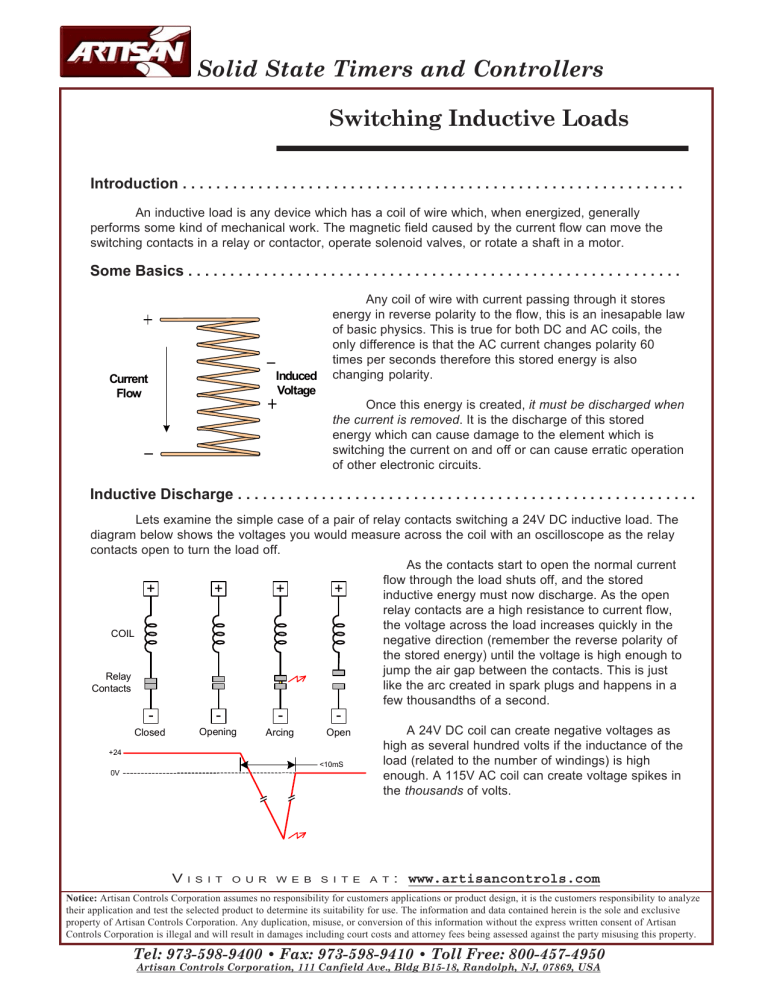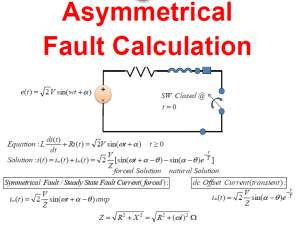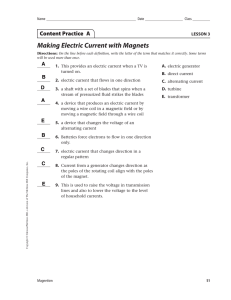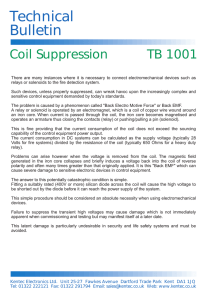
Solid State Timers and Controllers Switching Inductive Loads Introduction . . . . . . . . . . . . . . . . . . . . . . . . . . . . . . . . . . . . . . . . . . . . . . . . . . . . . . . . . . . . An inductive load is any device which has a coil of wire which, when energized, generally performs some kind of mechanical work. The magnetic field caused by the current flow can move the switching contacts in a relay or contactor, operate solenoid valves, or rotate a shaft in a motor. Some Basics . . . . . . . . . . . . . . . . . . . . . . . . . . . . . . . . . . . . . . . . . . . . . . . . . . . . . . . . . . . Induced Voltage Current Flow Any coil of wire with current passing through it stores energy in reverse polarity to the flow, this is an inesapable law of basic physics. This is true for both DC and AC coils, the only difference is that the AC current changes polarity 60 times per seconds therefore this stored energy is also changing polarity. Once this energy is created, it must be discharged when the current is removed. It is the discharge of this stored energy which can cause damage to the element which is switching the current on and off or can cause erratic operation of other electronic circuits. Inductive Discharge . . . . . . . . . . . . . . . . . . . . . . . . . . . . . . . . . . . . . . . . . . . . . . . . . . . . . . . Lets examine the simple case of a pair of relay contacts switching a 24V DC inductive load. The diagram below shows the voltages you would measure across the coil with an oscilloscope as the relay contacts open to turn the load off. As the contacts start to open the normal current flow through the load shuts off, and the stored + + + + inductive energy must now discharge. As the open relay contacts are a high resistance to current flow, the voltage across the load increases quickly in the COIL negative direction (remember the reverse polarity of the stored energy) until the voltage is high enough to jump the air gap between the contacts. This is just Relay like the arc created in spark plugs and happens in a Contacts few thousandths of a second. - - - - Closed Opening Arcing Open +24 <10mS 0V V I S I T O U R W E B S I T E A 24V DC coil can create negative voltages as high as several hundred volts if the inductance of the load (related to the number of windings) is high enough. A 115V AC coil can create voltage spikes in the thousands of volts. A T : www.artisancontrols.com Notice: Artisan Controls Corporation assumes no responsibility for customers applications or product design, it is the customers responsibility to analyze their application and test the selected product to determine its suitability for use. The information and data contained herein is the sole and exclusive property of Artisan Controls Corporation. Any duplication, misuse, or conversion of this information without the express written consent of Artisan Controls Corporation is illegal and will result in damages including court costs and attorney fees being assessed against the party misusing this property. Tel: 973-598-9400 • Fax: 973-598-9410 • Toll Free: 800-457-4950 Artisan Controls Corporation, 111 Canfield Ave., Bldg B15-18, Randolph, NJ, 07869, USA Solid State Timers and Controllers Negative Effects . . . . . . . . . . . . . . . . . . . . . . . . . . . . . . . . . . . . . . . . . . . . . . . . . . . . . . . . . . There are multiple negative affects which can be created by unsuppressed inductive energy discharges. Relay Contacts: The primary effect on relay contacts is damage to the plating on the contacts from the arcing. This will cause shortening of the contact life and reduction of the current handling capability. Solid State Switches: The potential effect of the large voltage spikes produced by inductive load switching can be even more serious on solid state switches. All solid state switching devices have maximum voltage ratings beyond which immediate damage will occur. The high voltage can punch through the insulating materials used internally to protect the device and create a short circuit. This permanently damages the device thereby requiring its replacement. All Artisan Controls products with solid state outputs employ protection against transient voltage spikes, but the protective devices used have limitations and if these limitations of voltage and transient energy are exceeded the product will still be damaged. Secondary Effects: The rapidly changing currents and voltages generated by unsuppressed inductive discharges produce high frequency noise which can affect other electronic devices. This electronic noise can be either tramsitted along the power and control wires of a system or can be radiated through the air. This electronic noise can interfere with the proper operation of digital and analog circuits, generally causing erratic operation or requiring the electronic device to be power cycled to restore normal operation. DC Suppression Techniques . . . . . . . . . . . . . . . . . . . . . . . . . . . . . . . . . . . . . . . . . . . . . . . Suppression of inductive load spikes on DC coils is simpler than on AC coils for the simple reason that the current flow through the coil is in only one direction. Connection of a diode with the cathode (striped end) towards the positive side of the coil easily supresses the voltage spike. During normal operation of the coil, the diode does not conduct any current as it is in its blocking state. Once the coil is turned off, its inductive energy starts producing the negative voltage as described on the first page. As soon as this induced voltage reaches about 0.7V in the opposite polarity the diode begins to conduct, effectively clipping the negative voltage spike. The current in the dumping of the spike can be rather large but it is very short in duration and any good quality diode can handle many times the current for short durations than they are rated for in their continuous conducting state. COIL W/DIODE COIL A rule of thumb is to select a diode which is rated for at least the same current as the coil draws, and at least twice the voltage rating of the operating voltage of the load. V I S I T O U R W E B S I T E A T : www.artisancontrols.com Notice: Artisan Controls Corporation assumes no responsibility for customers applications or product design, it is the customers responsibility to analyze their application and test the selected product to determine its suitability for use. The information and data contained herein is the sole and exclusive property of Artisan Controls Corporation. Any duplication, misuse, or conversion of this information without the express written consent of Artisan Controls Corporation is illegal and will result in damages including court costs and attorney fees being assessed against the party misusing this property. Tel: 973-598-9400 • Fax: 973-598-9410 • Toll Free: 800-457-4950 Artisan Controls Corporation, 111 Canfield Ave., Bldg B15-18, Randolph, NJ, 07869, USA Solid State Timers and Controllers AC Suppression Techniques . . . . . . . . . . . . . . . . . . . . . . . . . . . . . . . . . . . . . . . . . . . . . . . Suppression of inductive load spikes on AC coils is more difficult due to the constantly changing polarity of the load current. There are two basic type of components which can be used: COIL COIL W/CAP Capacitors: Connection of a ceramic or film capacitor across the load circuit will roll off the sharp edges of the voltage and current spikes. This simple method can be effective if the problem to be resolved is only noise supression. Capacitor values in the range of 0.1uF to 1uF are the most successful, and the voltage rating should be twice that of the supply voltage, generally 400V for 115V AC and 600V for 230V AC. If you are operating on 115/230V AC, you must select a capacitor which is UL listed for across-the-line suppression applications, the Panasonic ECQ series of capacitors are generally easy to source from local or online distributors. COIL W/MOV or TAZ Transient Suppressors: Capacitors have limited effect on the voltage spike generated, they generally only smooth the edges to prevent electrical noise. If your application is having problems with the voltage spikes transient suppressors must be used. These come in two styles: the MOV, ZNR, or varistor type is a resistancebased device which changes from high to low resistance once a voltage threshold is exceeded. They can handle high transient energies but have some limitations in switching time and with the clamping voltage with high transient currents. Tranzorb (or TAZ) type suppressors are semiconductor-based and switch very quickly but can not handle the high transient energies that MOV's can. Again, if you are operating on the AC mains, the Panasonic ERZ series MOV devices are easily sourced through distribution, and you must select those parts which are UL rated for across the AC line applications. We recommended usage of both capacitors and transient suppressors for maximum effectiveness in AC circuits, and UL listed components must be used in 115V or 230V systems. Important Note: If the inductive load is a contactor or motor starter, many manufacturers of these devices have transient suppressor packages which are made to connect directly to the coil terminals. These devices are strongly recommended as they have been designed and tested with the exact coil to which they are connected. Check with the manufacturer if you are suppressing these types of inductive loads. General Practices . . . . . . . . . . . . . . . . . . . . . . . . . . . . . . . . . . . . . . . . . . . . . . . . . . . . . . . . . The physical location of the selected suppression device will have very significant affect on its effectiveness. Any suppression device must be placed as close as possible to the inductive load, thereby minimizing the path of the current and voltage spikes. The ideal location is directly across the coil, but that is impractical in some instances, so these components must be connected as close as possible and with the shortest possible leads. It is the customers responsibility to analyze their application and perform the necessary tests on the selected suppression technique to determine its suitability for use in their product. V I S I T O U R W E B S I T E A T : www.artisancontrols.com Notice: Artisan Controls Corporation assumes no responsibility for customers applications or product design, it is the customers responsibility to analyze their application and test the selected product to determine its suitability for use. The information and data contained herein is the sole and exclusive property of Artisan Controls Corporation. Any duplication, misuse, or conversion of this information without the express written consent of Artisan Controls Corporation is illegal and will result in damages including court costs and attorney fees being assessed against the party misusing this property. Tel: 973-598-9400 • Fax: 973-598-9410 • Toll Free: 800-457-4950 Artisan Controls Corporation, 111 Canfield Ave., Bldg B15-18, Randolph, NJ, 07869, USA





